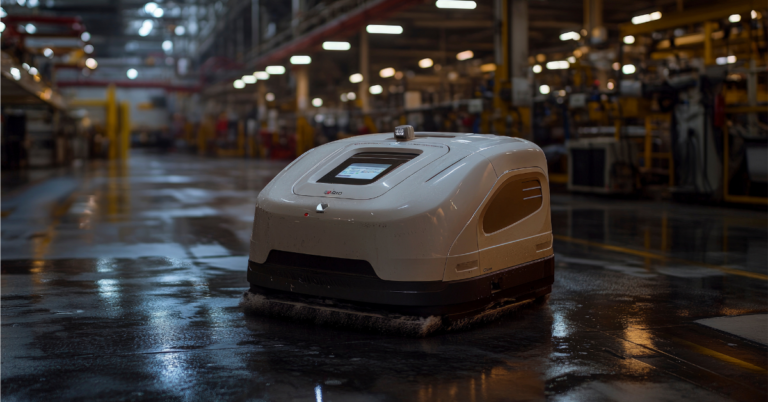As robotics continues to enter more industries, facilities management is quickly becoming an increasingly popular use case for automation.
It’s no secret that labor shortages have been a long-standing issue for businesses. Now that cleaning and sanitation have received increased attention after the pandemic, robots are stepping in to assist with streamlining facility service tasks.
Introducing automation into facilities management roles does more than simply relieve labor issues; it can also help promote productivity and effectiveness of tasks by removing the possibility of human error.
Let’s take a look at a few of the ways robotics are revolutionizing facilities management.
What are facilities management robots?
Before diving into their specific benefits, it’s important to define the use cases for robotics in facilities management, since there may be a few you wouldn’t expect.
Cleaning and sanitation indoors is one of the most common use cases for robotics in facilities that would come to mind- from automating the cleaning of hotel rooms to the sanitation of public spaces.
However, facilities management spans beyond the cleaning of indoor surfaces- it also to reaches outdoor environments and even beyond cleaning. Trombia for example is a company that offers robots for autonomous, fully electric street sweeping. Viabot is a similar company that not only offers robotic street sweeping (specializing on parking lots), but expanded its use cases to security, with the ability to provide 24/7 automated surveillance.
Autonomous mowing has also become a more common vertical that’s steadily picking up in popularity, with companies such as Electric Sheep, Graze, and Scythe Robotics fulfilling the increasing demand for autonomous mowers in commercial spaces.

Increase safety and compliance
In any environment, safety is one of the biggest concerns when it comes to facilities management.
The reality is, no matter how effective someone may be in their role human error is inevitable and can have widespread effects on the rest of the staff, such as a virus spreading. Robots minimize the possibility of human error and limit human contact with infected services.
It isn’t only healthcare facility workers that face safety issues; workers in other facilities’ environments face safety issues such as exposure to potentially toxic chemicals, environmental hazards, and safety threats for security workers. Robots aren’t at nearly as much risk in these situations and enable humans to take a step back and monitor the performance of tasks from a safe distance.
For example, when a robot is utilized for a security role, its human counterpart can monitor any potential threats remotely to decide how to handle them properly and minimize the most risk to others.
Compliance is another large area of focus in facilities management. Many facility tasks require meticulous processes that are step-by-step and need strict adherence to consistently meet quality standards. Being that robots are programmed to only focus on the task at hand, distractions are eliminated and each process can be carried out exactly as is intended.
Ensure efficiency
There’s no shame in getting sidetracked- as humans, it’s easy to become distracted however this can quickly lead to losing precious time during shifts and potentially falling behind on tasks or not completing them as successfully as possible.
Adding robots to the equation safeguards processes from these distractions and provides humans with the ability to monitor performance and understand how it could be consistently improved. Robots also don’t have to require breaks or time off, so they can work around the clock to complete tasks earlier and more often than before so environments are cleaner and more secure than ever before.
Save on costs and uplift workers
The idea of implementing automation into facilities management practices sounds great, but what does the reality of adopting them look like?
Robots are typically thought of as an expensive undertaking, but modern robotics-a-service models are changing how easily robots can be deployed into facilities- and it doesn’t require prior knowledge of robotics, either. Rather than purchasing the hardware exclusively (which can be quite costly), RaaS offers the ability to rent or lease robots via a subscription-based model.
This not only offers the ability to be flexible as needed in terms of robots, but also includes technical support from the RaaS provider to alleviate any worry of losing productivity to troubleshooting internally.
A common concern with bringing robots into a new environment can be how current staff will work alongside their robotic counterparts. Of course, human workers are valuable in facilities management- no robot can replace critical thinking skills, leadership, attention to detail, etc.; however, they can provide the opportunity to upskill current workers.
Contrary to popular belief, prior experience working with robots isn’t always required for working alongside them. Jobs such as monitoring robots, such as Ascento, a robotic security company, offer the ability to gain robot literacy with no prior tech experience.
An added benefit of bringing robots into the mix is cost savings; robots don’t require extra commitments such as medical benefits or paid time off, saving money while increasing efficiency and helping to lighten the workload for human workers. Whether it be through monitoring robots or supplementing a short-staffed team with them, introducing robots into facilities services roles can greatly benefit humans and overhead costs.
We’ve all heard that automation is inevitable, but for facilities management, the introduction of automation will be beneficial for optimizing multiple processes in the middle of an ongoing labor shortage. From sanitation to environmental cleanup, security, and more, robots are already evolving the way we tackle facilities services.
To learn more about how Formant helps facilities management robotics companies, get a tailored demo.



